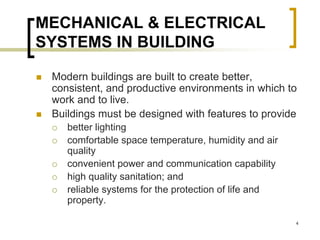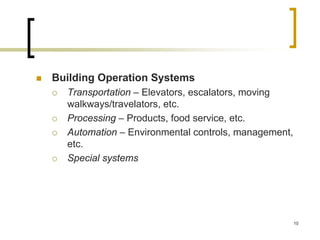Building services -
- 1. INTRODUCTION TO BUILDING SERVICES Mohd Rodzi Ismail
- 2. 2 WHAT IS BUILDING SERVICES? ? Imagine yourself in the most fabulous building in the world. Now take away the lighting, heating and ventilation, the lifts and escalators, acoustics, plumbing, power supply and energy management systems, the security and safety systems...and you are left with a cold, dark, uninhabitable shell. ? Everything inside a building which makes it safe and comfortable to be in comes under the title of 'Building Services'. A building must do what it was designed to do - not just provide shelter but also be an environment where people can live, work and achieve.
- 3. 3 ? Building services are Ą°what makes a building come to lifeĄą. They include: { energy supply - gas , electricity and renewable sources { heating and air conditioning { water, drainage and plumbing { natural and artificial lighting, and building facades { escalators and lifts { ventilation and refrigeration { communication lines, telephones and IT networks { security and alarm systems { fire detection and protection
- 4. 4 MECHANICAL & ELECTRICAL SYSTEMS IN BUILDING ? Modern buildings are built to create better, consistent, and productive environments in which to work and to live. ? Buildings must be designed with features to provide { better lighting { comfortable space temperature, humidity and air quality { convenient power and communication capability { high quality sanitation; and { reliable systems for the protection of life and property.
- 5. 5 ? All these desirable features have become a reality with advances in building M&E systems ? Block-type buildings without windows, such as department stores, are totally dependent on electrical lighting, ventilation and space conditioning ? High-rise buildings must rely on high-speed vertical transportation and high ĻCpressure water for drinking and cleaning purposes and for protection against fire
- 6. 6 ? Impact M&E systems on buildings: { Demand considerable amounts of floor and ceiling space ĻC proper space allocation is needed during the preliminary planning { Add to the cost of construction of a building ĻC sophisticated buildings, such as research buildings, hospitals, computer centres { Increase in energy consumption ĻC energy consumed by occupied buildings, including residential, commercial, institutional and industrial facilities, account for 50% of all energy usage by an industrialised country; it also accounts for large portion of the operating costs of such buildings
- 7. 7 ? The complexity of M&E systems varies with: { Living standards of the society { Climatic conditions of the region { Occupancy and quality of the building
- 8. 8 CLASSIFICATION OF M&E SYSTEMS ? Mechanical Systems { HVAC (Heating, ventilating, and air- conditioning)/ACMV (Air-conditioning and mechanical ventilation) { Site utilities ĻC Water supply, drainage, sanitary disposal, gas supply { Plumbing ĻC Water distribution, water treatment, sanitary facilities, etc. { Fire protection ĻC Water supply, standpipe, fire and smoke detection, annunciation, etc. { Special systems
- 9. 9 ? Electrical Systems { Electrical power ĻC Normal, standby, and emergency power supply and distribution { Lighting ĻC Interior, exterior, and emergency lighting { Auxiliary ĻC Telephone, data, audio/video, sound, security systems, etc. { Special systems
- 10. 10 ? Building Operation Systems { Transportation ĻC Elevators, escalators, moving walkways/travelators, etc. { Processing ĻC Products, food service, etc. { Automation ĻC Environmental controls, management, etc. { Special systems
- 11. 11 CHECKLIST OF BUILDING AND M&E REQUIREMENTS ? A comprehensive checklist that serves to determine the scope of building operational requirements and from which one can determine the scope and criteria of M&E systems. ? Valuable in formulating the architectural concept, building configuration, space programming, and opportunities of system interfacing. ? Early identification of these requirements will aid in evaluating construction cost, as well as the allocation of space for M&E equipment, both within interior and exterior of the building.
- 12. 12 ? Mechanical Systems { Include heating, ventilating, and air-conditioning (HVAC)/air-conditioning and mechanical ventilation (ACMV), plumbing and sanitation (P&S), fire protection (F&P), and specialty or auxiliary systems. { Not all buildings require all services; thus the list should be tailored to the needs of a specific project.
- 13. 13 ? HVAC/ACMV Systems { Energy source ĻC Electrical power, gas, oil, coal, central steam, central hot water, chilled water, etc. (location and capacity) { Heating/cooling ĻC Central air handling, direct radiation, in-space unitary equipment, etc. { Comfort controls ĻC Number of control zones, humidity, temperature, etc. { Central plant ĻC Estimated normal (or base) and standby capacities, etc. { Heat rejection - Water cooling tower, air cooled condenser, evaporative cooler, etc. { Location of equipment ĻC Central equipment rooms, on floor, on roof, on ground, etc.
- 14. 14 { Ventilation ĻC Outside air requirements (minimum, high, or 100%) { Exhaust - General, food preparation, toxic and special exhaust systems, etc. { Automation ĻC Building automation system (BAS), building management system (BMS)
- 15. 15 ? Plumbing and Sanitation Systems { Energy source ĻC Electrical power, gas, oil, central steam, hot water, etc. { Water supply ĻC Public water, river, well, etc.; water pressure, capacity available, and location { Hot water supply ĻC Hot water heaters or heat exchangers { Sewage disposal ĻC Sanitary, sewers, sewage treatment plant, septic tanks, drainage and filtering fields { Storm/Rain water drainage ĻC Roof, area, and means of discharge; locations { Subsoil drainage ĻC Drainpipes, sumps, pumps, and discharge, etc. { Building facilities ĻC Plumbing fixtures, water, waste, soil, piping
- 16. 16 ? Fire Protection Systems { Energy source ĻC Electrical power, gas, oil { Water supply ĻC Flow rate and available pressure at water main, location. Separate service or combination with plumbing water supply { Water storage ĻC Lake, pond, storage tanks (locations and capacities) { Fire and smoke detection ĻC Thermal and smoke detectors { Fire containment ĻC Fire shutters, compartmentalization { Smoke containment and evacuation ĻC Smoke exhaust and pressure controls { Stairway smoke prevention ĻC Stair pressurization
- 17. 17 { Fire annunciation ĻC Fire alarm, public address, fire department connections { Fire extinguishing ĻC Portable extinguishers, automatic sprinklers (water, mist, dry chemical, foam, special gases, etc.) { Fire fighting ĻC Fire hose and standpipe systems { Lightning protection ĻC Air terminals, grounding conductors, etc.
- 18. 18 ? Electrical Systems { Include power, lighting, and auxiliary systems. { The proliferation of electrical and electronic systems in building applications has greatly expanded the scope of electrical systems and has had a drastic impact on construction costs and the complexity of planning. { The list should be expanded or condensed to fit the needs of a specific project.
- 19. 19 ? Power Systems { Normal energy source ĻC Utility power or on-site power (location and capacity); power characteristics (phase and voltage); service entrance (overhead, underground); service requirements (substations, transformer vaults); etc. { Emergency power source ĻC Separate utility service or on-site standby generators (location and capacity) { Interior power distribution ĻC Primary or secondary voltages, unit substations, distribution panels, etc. { On-floor distribution ĻC Floor boxes, under-floor ducts, integrated cellular floors, raised floors, ceiling-cavity conduit network, etc.
- 20. 20 { Emergency power distribution ĻC For critical equipment and emergency lighting loads { Uninterruptible power systems (UPS) ĻC For critical building operations such as computers and communication networks; power storage (battery banks) { Power for building systems ĻC HVAC, plumbing, sanitary, fire protection, etc. { Power for building operational equipment ĻC Food service, waste disposal, laundry, garage, entertainment equipment, etc. { Power for vertical transportation systems ĻC Interface with elevator consultant on power and controls for elevators and escalators
- 21. 21 ? Lighting Systems { Basic light source ĻC Incandescent, fluorescent, high intensity discharge (HID), etc. { Illumination ĻC Lighting levels, colour rendering, controls { Lighting fixtures ĻC In offices and other work spaces { Architectural lighting ĻC Interface between architect, lighting and/or electrical consultant on public or special spaces { Introduction of daylight ĻC Fenestration, skylights, controls, etc. { Exit lighting ĻC Exit signs, exit way (evacuation route) light { Exterior lighting ĻC Site, landscape, building facade, aircraft warning lights, etc.
- 22. 22 ? Auxiliary Systems { Telephone and telecommunication ĻC Type, number of lines and stations, switchboard (manual, PBX), basic and special features, facsimile, modem, etc. { Data distribution systems ĻC Multiple conductor cables, twisted pairs, coaxial cables, Fibre optic cables, wire closets, etc. { Public address ĻC Intercom, paging and music systems { Audio/video ĻC Radio, TV, and signal distribution systems { Satellite dishes ĻC Number, diameter, and orientation { Transmission ĻC Transmitter and microwave towers { Cable ĻC CCTV distribution systems, locations, and interfacing with other auxiliary systems { Time and signal ĻC Clock and program systems { Fire detection and alarm systems ĻC Interface with fire protection consultants { Automatic controls ĻC Interface with HVAC and other building service consultants { Security systems ĻC CCTV monitoring, detecting, alarming, controlling, and interface with security consultant { Specialty systems ĻC Numerous specialty systems for hospitals, research, computer centres, and industrial, military, or defence facilities, as applicable
- 23. 23























